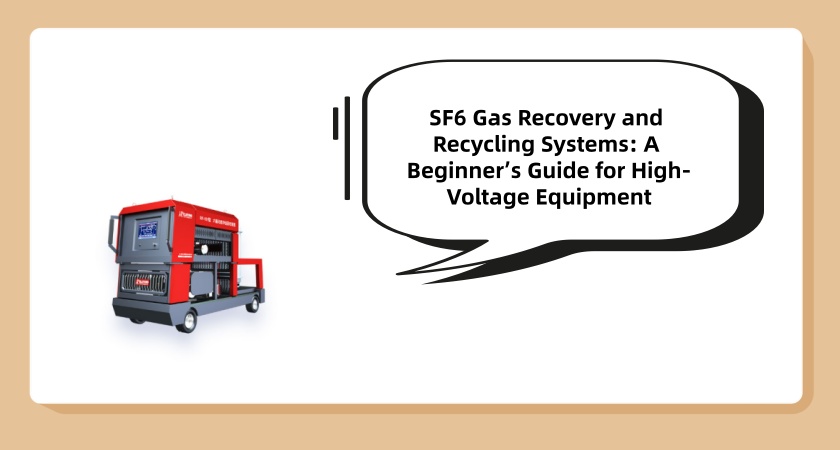Sulfur hexafluoride (SF6) is a cornerstone of high-voltage electrical systems—used in circuit breakers, switchgear, and transformers—thanks to its unmatched insulating and arc-extinguishing capabilities. But with a global warming potential (GWP) 23,500 times that of CO₂ over 100 years, SF6 is one of the most potent greenhouse gases. For beginners in the field, mastering SF6 gas recovery and recycling systems is non-negotiable: these systems ensure regulatory compliance, cut costs, and protect both personnel and the environment. This guide breaks down the basics, importance, and implementation steps for new users.
What is SF6 Gas & Why Recovery Matters?
SF6 is a colorless, odorless gas six times heavier than air, prized for its ability to stabilize high-voltage equipment. However, its environmental impact has spurred strict global regulations—including the EU F-Gas Regulation and IEC 60480 standards—mandating <0.5% annual emissions and 98%+ recovery rates. For beginners, understanding SF6 recovery’s core value is key:
Compliance: Avoid fines (up to €300,000 in the EU) by meeting emission limits.
Cost Savings: Recycle 98-99.5% of SF6, reducing new gas purchases by 40% and cutting operational costs.
Safety: Prevent oxygen displacement or toxic byproduct exposure in confined spaces.
Efficiency: Maintain equipment performance by reusing pure SF6, minimizing downtime from failures.
Key Components of SF6 Recovery & Recycling Systems
Beginner-friendly F6 gas recovery and recycling systems are modular and intuitive, with these essential components:
Gas Recovery Units: The core component, capturing SF6 from equipment during maintenance. Look for 98%+ recovery efficiency (industry benchmark) and compatibility with 15-100 bar pressure ranges.
Purification Systems: Remove impurities (moisture, oil, oxygen) via filtration or chemical treatment, ensuring gas meets 99.9% purity standards for reuse.
Drying Technologies: Molecular sieves or desiccant systems eliminate moisture—critical, as even small amounts degrade SF6’s insulating properties.
Monitoring & Control: Real-time tracking of gas levels, pressure, and purity via digital dashboards. Look for leak detection (0.1 ppm sensitivity) to alert operators to issues.
User-Friendly Interfaces: Intuitive controls and visual/audio alerts reduce human error, ideal for teams new to SF6 handling.
Step-by-Step Implementation for Beginners
Implementing a F6 gas recovery and recycling system doesn’t require advanced expertise—follow these actionable steps:
Assess Your Needs: Calculate SF6 volume (10-200 kg/h), equipment types (switchgear/circuit breakers), and maintenance frequency. For example, small labs need portable units, while utilities require stationary systems.
Choose Beginner-Friendly Equipment: Prioritize ISO 9001-certified brands (e.g., DILO, ABB) with integrated recovery-purification-drying modules. Avoid overly complex systems—modular designs are easier to learn and upgrade.
Train Your Team: Complete manufacturer-provided training on safety protocols (e.g., PPE use in confined spaces) and system operation. 1-2 day sessions are typically sufficient for basic proficiency.
Establish Simple SOPs: Draft step-by-step guidelines for SF6 recovery, storage, and emergency response. Include: “Shut off equipment before recovery” and “Log gas purity levels after purification.”
Routine Monitoring & Maintenance: Schedule monthly checks for leaks, filter replacements, and pressure calibration. Keep records to simplify compliance audits.
Common Challenges for Beginners (and Quick Fixes)
New users often face these hurdles—here’s how to overcome them:
Leak Detection: Use infrared or ultrasonic detectors (0.1 ppm sensitivity) to spot leaks early; conduct quarterly inspections for high-voltage equipment.
Contaminant Management: Invest in integrated purification-drying systems to avoid reusing impure gas—this prevents equipment damage.
Regulatory Confusion: Partner with suppliers that provide compliance updates (e.g., new F-Gas rules) and pre-built audit logs.
For beginners, SF6 gas recovery and recycling systems don’t have to be intimidating. By focusing on core components, simple implementation steps, and beginner-friendly equipment, you can quickly master compliance, safety, and cost efficiency. As global sustainability efforts intensify, these systems are no longer optional—they’re a foundational part of responsible high-voltage equipment management.
Whether you’re a utility team, manufacturing plant, or research lab, starting with a modular, intuitive system and following best practices will set you up for success. By prioritizing SF6 recovery and recycling, you’ll protect the environment, avoid fines, and keep your operations running smoothly—all while learning the ropes of SF6 management.


Leave A Message
Your email address will not be published. Required fields are marked *